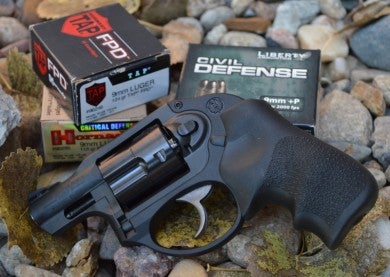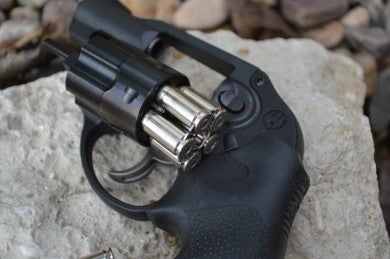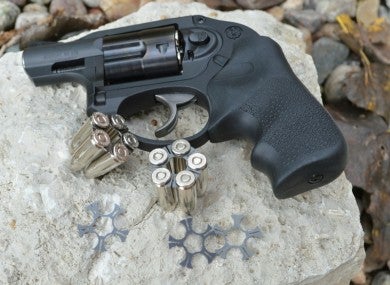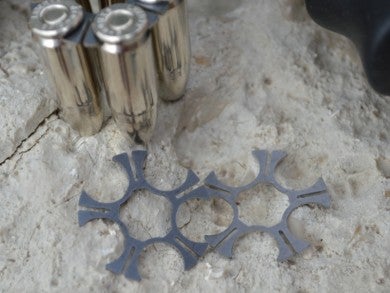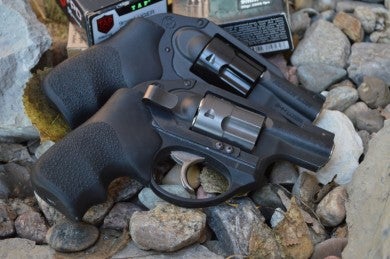Review: Ruger LCR-9 9mm Revolver
Major Pandemic 11.17.14
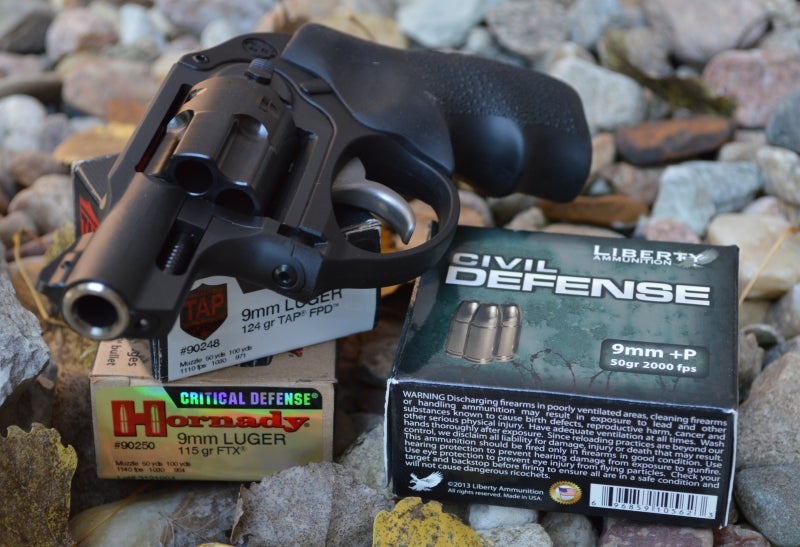
Based on my testing and the testing of other novice shooters who have shot and handled the Ruger LCR-9, I would like to declare this my pick for any new shooter entering the market and looking for their first gun. This gun is simple–really simple. It reloads fast, is light, is capable of digesting a huge array of 9mm ammo, and can be made “safe” more easily than most handguns. Bluntly put, this is the best defensive snubby revolver design I have tested, ever.
Yes sir, Ruger is back to offering 9mm revolvers again, and this has to be one of my favorite variants yet. The crazy thing about this revolver is that it is a polymer handgun just like the rest of the LCR line. Oh how guns have changed. Back when I was a kid, if someone suggested plastic on a handgun they were looked at strangely, if you would have suggested a polymer based revolver–well, you could have been institutionalized. Although H&K and Glock initially broke through the polymer barrier for semi-auto pistols, it is Ruger who has crossed the river of skepticism for Polymer revolvers with their LCR (Lightweight Compact Revolvers) line.
I am a fan of the LCR design, and I own a Ruger LCR-22 and KLCR-357. When Ruger introduced the 9mm version, I could not hit the order button fast enough. Despite the SP101 in 9mm being the single toughest revolver in the world to find while it was available, the 9mm chambering only lasted a short time before it was discontinued and I was extremely disappointed that I was not able to buy one.
The challenge with the extremely heavy, tank-like SP101 chambered in 9mm was that it was more of a novelty caliber. Almost everyone who wanted the SP101 wanted it in the standard .357 magnum chambering versus 9mm, but never fear. The LCR 9mm is here and it rocks.
Fit and Feel
Ruger usually does an excellent job on fit and finish, but I was a bit disappointed with the first generation LCR 357. With the LCR-9, however, Ruger has clearly sorted out those fitment issues on the newer models. To drop the price a bit, Ruger has also forgone the final surface finishing of the respective monolithic aluminum and stainless frames, but this yields a nice matte tactical texture for this type of revolver. This 9mm LCR has already seen a beating, so honestly I could care less about how pretty the finish looks.
As many know, Ruger has basically two frame sizes for the LCR line: the larger, heavier .357 magnum version and the marginally lighter .38 Special version. The 7000 Series Aluminum Monolithic framed .38 Special LCR versions start in the 13oz range and the heavier 400 Series Stainless Steel monolithic framed LCR-357 and LCR-9 both hover in the 17.1oz range. The LCR 9MM appears to be based on the heavier .357 magnum frame. Regardless of which LCR you have in your hand, they all provide perfect cross training analogs in weight, feel, and operation.
Because I was shipped one of the first 9mm LCRs off the line, someone along the way had forgotten to add in the three included full moon clips that hold the 9mm rounds, but Ruger sent them right out to finish up the testing for the article. It should be noted that the LCR 9 cannot be fired without the full moon clips. Not adhering to this requirement may result in some significant problems for you and the gun.
Features
The LCR is unique from a couple of perspectives. They have hybrid polymer lower sub-frames supported by upper monolithic metal frames, with stainless lined barrels and solid heavily fluted stainless cylinders. The lower polymer sub-frame drops a considerable amount of un-needed weight in the unstressed areas of the revolver, while the monolithic upper metal frames take the stress of the recoil. When you combine that with a stainless barrel and cylinder you still have a incredibly strong, reliable revolver, but one that’s almost a pound lighter than Ruger’s SP101 line.
As the concealed hammer indicates, the LCR is primarily a lean and mean personal defense revolver, but Ruger wanted to ensure the trigger pull did not suffer and developed a friction reducing cam, which results in a incredibly smooth, non-stacking trigger pull. All the neat-o polymer and monolithic frame stuff aside, it is the trigger that steals the show for the LCR and makes it exceptionally accurate for a snub nosed revolver.
Ruger thankfully has started to integrate safety gun locks into their firearms, but I think they missed the functional mark on the LCR line. The LCR has a lock, but you need to inconveniently remove the grip and use the key to unlock the action then presumably replace the grip and grip screw. A hole through the grip to use the key to unlock the action would been a more user friendly option, which I may remedy with a drill bit. I like the integrated lock, but the supplied Ruger padlock’s shackle placed behind the trigger or through the frame will render a loaded LCR safe and prove a faster, more useful lock.
Functions
Functionally the LCR-9 performed flawlessly and shot everything I stuffed into the cylinders. With the very wide variety of 9mm ammo these days, from low recoil to very hot +P ammo, the shooter has a lot to choose from. One point many may miss is the the LCR-9 can pay for itself quickly for those who want to practice and shoot a lot with the gun. There for a while 9mm ammo was around the same price as .22LR ammo. Currently 9mm ammo is still about 20% less than .357 or .38 special rounds. This savings could add up quick for shooters.
The LCR needs to have the triggers heavily stroked. As with any revolver, you cannot let your finger feel for the trigger reset like you do on any semi-auto, or you will just spin the cylinder at the first trigger reset or lock the trigger until you reset your finger. Because of the cam, this usually unnoticed reset cycle seemed a little more noticeable to me on the .357 version but better on this LCR-9; however, most folks probably will not notice it. This little annoyance only reared its head when I was shooting groups from the bench and carefully controlling the trigger.
The sights are simple on the LCR line, with a front pinned replaceable sight and a rear notch. Grips and recoil reduction are handled by the super comfortable Hogue/Ruger designed Sorbothane inserts, which tame even the heaviest 9mm rounds to tolerable levels and allow you to shoot through a box of ammo quickly without swearing.
Where some may see the requirement to use full moon clips to feed the revolver a problem, I see this as the holy grail of defensive snubbies. The best speed loader in the world for a revolver remains the full moon clip. Full moon clips are essentially thin steel wafer bodies that the rounds clip into and function in this case as an extension of the cartridge to hold the 9mm round for loading, firing, and unloading. All five rounds go in and out of the gun as a unit at once. Of course, the full moon clips do not need to be full to use them. You can load as many or as few rounds as you want into the clips.
The full moon clips hold the ammo securely and allow the smallest, most efficient, and most consistent reloading system available for a revolver. Even fumbling a bit in the dark, you start to feel like a competition revolver shooter doing speed loads. The reload sequence is fast–very fast. Thank you Ruger. This is the CCW snubby I have been wanting all my life. Now I can just drop a full moon clip or two in my support hand pocket and I am ready to roll out the door. Due to my love of the ClipDraw system on my LCR-357, this gun will definitely have the Universal ClipDraw attached ASAP. Range cleanup is also easy. Just reach down and pick up your full moon clips with all the casings still attached. Ruger’s full moon clip allows unfired ammo or empty casings to be removed with just fingernail pressure against the top of the case rim.
Accuracy
Like the LCR-357, the LCR-9 is exceptionally accurate from a defensive perspective. Using LIberty Critical Defense 50gr and Hornady 9MM LUGER+P 135 GR FLEXLOCK CRITICAL DUTY 9MM LUGER +P 124 GR TAP FPD, I saw consistent 3”-4” groups at 25 yards from sandbags and could easily keep the 50 yard silhouette swinger ringing as well off hand. My best group of the day was 2.5” at 25 yards from the 124Gr Hornadys, which I was thrilled with. I repeated my 7 yards one ragged hole 15-round test with the LCR-9. The verdict of the LCR-357 is that it is a great shooting revolver for defense. Of course, I probably wouldn’t use it for hunting squirrels, and it certainly does not match what my 4” and 6” GP100 revolvers deliver.
Final Thoughts
The LCR-9 is an accurate concealed carry and personal defense revolver that is light and Crayon easy to operate. The LCR-9 would be my first recommendation for someone wanting a handgun for defense, even over the other LCR lineup. Revolvers are really simple, easy to figure out, and easy to reload, especially with the full moon clips exclusively used for this 9mm revolver. Revolvers also require far less training to use competently than a semi-auto pistol. There are no clearing or Condition 1 failure (failure to ignite) maneuvers other than to pull the trigger again.
In my opinion revolvers can be a bit safer because in most cases you can see the bullets in the chamber and quickly secure the revolver to an inoperable state with just a padlock. This is a key safety feature for new shooters. The LCR-9 is a bit heavier that the regular LCR-38 line, but it shoots everything from light 9mm rounds to the heavy +P rounds. It provides a huge amount of versatility.
Polymer is here to stay, and Ruger has utilized it in the right way with the LCR line up to deliver light, solid, reliable, and accurate revolvers. Hundreds of rounds later, I am confident in the LCR-9 as a defensive revolver. In fact, with the full moon clip capabilities of dramatically increasing speed loading, the LCR-9 is at the top of my list for recommended defensive handguns. The full moon clips overcome one of the major stumbling blocks to getting ammo reliably in and out of a revolver.
I think Ruger hit a home run on the design of the LCR-9
SPECS
- Ruger KLCR-357
- Model Number: 5450
- Caliber: 9mm
- Finish: Blackened Stainless
- Grip: Hogue® Tamer™
- Front Sight: Replaceable, Pinned Ramp
- Rear Sight: U-Notch Integral
- Barrel Material: Stainless Steel
- Monolithic Frame: Blackened 400 Series Stainless Steel
- Cylinder Finish: Advanced Target Grey®
- Barrel Length: 1.875″
- Overall Length: 6.50″
- Height: 4.50″
- Width: 1.28″
- Weight: 17.10 oz.
- Capacity: 5
- Twist: 1:16″ RH
- Grooves: 6
- MA Approved and Certified: Yes
- CA Approved: Yes
- Suggested Retail: $599.00
